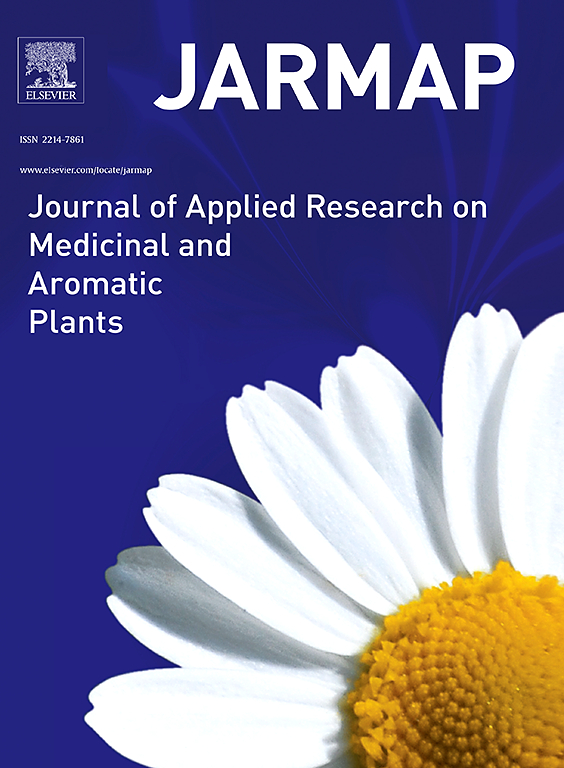Analysis of genetic diversity and population structure of Pinellia ternata using EST-SSR markers
IF 3.6
2区 农林科学
Q1 PLANT SCIENCES
Journal of Applied Research on Medicinal and Aromatic Plants
Pub Date : 2025-02-01
DOI:10.1016/j.jarmap.2024.100611
引用次数: 0
Abstract
Pinellia ternata (Thunb.) Breit. is a widely used Chinese Medicinal Material with economic and medicinal value. Few molecular studies have been conducted on P. ternata, resulting in a lack of applicable molecular markers. This present research analyzed the genetic diversity of 255 P. ternata germplasm resources from China, including 117 wild germplasm resources and 138 cultivated germplasm resources. Following the development of 17 pairs of highly polymorphic primers, 126 alleles were found; the average polymorphism was 99.21 %. The average number of observed alleles (Na), effective alleles (Ne) were 1.98 and 1.36, respectively. The mean of the Nei genetic diversity index (H), the Shannon's information index (I) and the polymorphic information content (PIC) were 0.23, 0.36 and 0.6482, respectively. The population structure of P. ternata germplasm resources was categorized into two groups, designated as Group 1 and Group 2. The majority of wild germplasm resources was clustered in Group 1. Phylogenetic and population structure analyses produced similar results. A comparison of the genetic diversity parameters of wild and cultivated germplasm revealed that the genetic diversity was higher in the former, while the genetic differentiation level of the two types of germplasm was low. Analysis of molecular variance (AMOVA) demonstrated that 9 % of the genetic variation was between populations and 91 % of the genetic variation was within populations. Principal coordinate analysis (PCoA) served to corroborate the findings of the cluster and population structure analysis. It was found that P. ternata with tubers having red epidermis was more separated from other germplasm resources. Association analysis based on the generalized linear model (GLM) detected four EST-SSR markers significantly associated with P. ternata tuber color. This study will be helpful for P. ternata germplasm resource conservation, identification and trait-specific breeding programs.
利用EST-SSR标记分析半夏的遗传多样性和群体结构
半夏(Pinellia ternata)布莱特。是一种广泛使用的中药材,具有经济和药用价值。目前国内外对紫檀的分子研究较少,缺乏适用的分子标记。本研究分析了255 P的遗传多样性。其中,野生种质资源117种,栽培种质资源138种。经过17对高多态性引物的开发,共发现126个等位基因;平均多态性为99.21 %。平均观察到的等位基因数(Na)和有效等位基因数(Ne)分别为1.98和1.36。Nei遗传多样性指数(H)、Shannon信息指数(I)和多态性信息含量(PIC)的平均值分别为0.23、0.36和0.6482。柽柳种质资源的种群结构可划分为2个类群,分别为类群1和类群2。大部分野生种质资源集中在类群1。系统发育和种群结构分析也得出了类似的结果。野生和栽培种质的遗传多样性参数比较表明,野生和栽培种质的遗传多样性较高,而两种种质的遗传分化水平较低。分子变异分析(AMOVA)表明,9 %的遗传变异发生在群体间,91 %的遗传变异发生在群体内。主坐标分析(PCoA)证实了聚类分析和种群结构分析的结果。结果表明,块茎表皮呈红色的藤属植物与其他种质资源的分离程度较高。基于广义线性模型(GLM)的关联分析检测到4个EST-SSR标记与块茎颜色显著相关。本研究将为柽柳种质资源的保护、鉴定和性状选育提供依据。
本文章由计算机程序翻译,如有差异,请以英文原文为准。
求助全文
约1分钟内获得全文
求助全文
来源期刊

Journal of Applied Research on Medicinal and Aromatic Plants
Pharmacology, Toxicology and Pharmaceutics-Drug Discovery
CiteScore
6.40
自引率
7.70%
发文量
80
审稿时长
41 days
期刊介绍:
JARMAP is a peer reviewed and multidisciplinary communication platform, covering all aspects of the raw material supply chain of medicinal and aromatic plants. JARMAP aims to improve production of tailor made commodities by addressing the various requirements of manufacturers of herbal medicines, herbal teas, seasoning herbs, food and feed supplements and cosmetics. JARMAP covers research on genetic resources, breeding, wild-collection, domestication, propagation, cultivation, phytopathology and plant protection, mechanization, conservation, processing, quality assurance, analytics and economics. JARMAP publishes reviews, original research articles and short communications related to research.
 求助内容:
求助内容: 应助结果提醒方式:
应助结果提醒方式:


